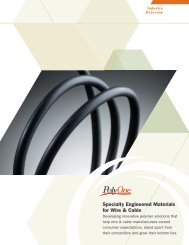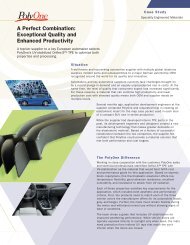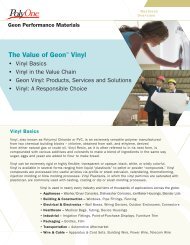Biomaterials Development in the Polymer Industry Asset ... - PolyOne
Biomaterials Development in the Polymer Industry Asset ... - PolyOne
Biomaterials Development in the Polymer Industry Asset ... - PolyOne
Create successful ePaper yourself
Turn your PDF publications into a flip-book with our unique Google optimized e-Paper software.
Technical<br />
Bullet<strong>in</strong><br />
<strong>Biomaterials</strong> <strong>Development</strong> <strong>in</strong> <strong>the</strong><br />
<strong>Polymer</strong> <strong>Industry</strong><br />
Connection to Susta<strong>in</strong>ability<br />
Susta<strong>in</strong>ability is commonly referred to as <strong>the</strong> “Triple Bottom L<strong>in</strong>e,” or people, planet and profit. This bus<strong>in</strong>ess<br />
philosophy balances f<strong>in</strong>ancial considerations with environmental and societal implications. A significant<br />
element of susta<strong>in</strong>ability is <strong>the</strong> recognition that <strong>the</strong> Earth’s resources are f<strong>in</strong>ite. As <strong>the</strong> global human<br />
population cont<strong>in</strong>ues to grow exponentially, <strong>the</strong> stra<strong>in</strong> on our f<strong>in</strong>ite resources will be ever <strong>in</strong>creas<strong>in</strong>g, creat<strong>in</strong>g<br />
<strong>the</strong> need for <strong>in</strong>novative, susta<strong>in</strong>able solutions. The concepts of susta<strong>in</strong>ability can be applied broadly to <strong>the</strong><br />
polymers <strong>in</strong>dustry on many levels.<br />
Paper or Plastic?<br />
While most plastics are petroleum based, <strong>the</strong>y generally offer significant f<strong>in</strong>ancial, environmental, and societal<br />
benefits compared to traditional materials such as metal, glass and paper:<br />
• Lower total energy cost to manufacture and transport.<br />
• Light weight (transport, ergonomics)<br />
• Energy sav<strong>in</strong>gs (<strong>the</strong>rmal <strong>in</strong>sulation properties)<br />
• Safety (handl<strong>in</strong>g, breakage, electrical <strong>in</strong>sulation)<br />
• Durability<br />
“While most plastics are petroleum based, <strong>the</strong>y generally<br />
• Design Freedom<br />
offer significant f<strong>in</strong>ancial, environmental, and societal<br />
• Ability to Recycle<br />
benefits compared to traditional materials such as metal,<br />
• Ease of Energy Recovery<br />
glass and paper.”<br />
The “7 R’s” of Susta<strong>in</strong>ability<br />
With<strong>in</strong> <strong>the</strong> plastics world, some advocates have expanded <strong>the</strong> scope of susta<strong>in</strong>ability concepts to <strong>in</strong>clude “7<br />
R’s”. Below are <strong>the</strong>se concepts along with some possible examples:<br />
1. Reduce: down-guage or reduce packag<strong>in</strong>g contents relative to product content; reduce energy<br />
consumption through <strong>in</strong>creased throughputs, process efficiencies, or reduced process<strong>in</strong>g temperatures<br />
2. Reuse: returnable packag<strong>in</strong>g; refillable, reusable products<br />
3. Recycle: reprocess<strong>in</strong>g materials <strong>in</strong>to useful applications at end of useful life<br />
4. Remove: elim<strong>in</strong>ate less environmentally attractive additives and <strong>in</strong>gredients from product and packag<strong>in</strong>g<br />
5. Renew: manufacture from renewable resources (i.e. plants) ra<strong>the</strong>r than deplet<strong>in</strong>g f<strong>in</strong>ite resources such<br />
as oil, metals, and o<strong>the</strong>r materials<br />
6. Read: cont<strong>in</strong>ual learn<strong>in</strong>g and education<br />
7. Revenue: actions need to make f<strong>in</strong>ancial sense and create economic value for society<br />
This list of considerations highlights <strong>the</strong> fact that <strong>the</strong>re are many options available to reduce <strong>the</strong><br />
environmental footpr<strong>in</strong>t and societal impact of plastics through material selection, part design, process<strong>in</strong>g,<br />
packag<strong>in</strong>g, and supply cha<strong>in</strong> considerations. Among <strong>the</strong>se options is <strong>the</strong> broad class of “biomaterials” or<br />
“biopolymers.”<br />
“...<strong>the</strong>re are many approaches available to reduce <strong>the</strong><br />
environmental footpr<strong>in</strong>t and societal impact of plastics<br />
through material selection, part design, process<strong>in</strong>g,<br />
packag<strong>in</strong>g, and supply cha<strong>in</strong> considerations.” Renewable<br />
or Bio-based materials are an emerg<strong>in</strong>g consideration.
Biopolymers: Historical View and Trends<br />
It is important to note that many large companies have made significant f<strong>in</strong>ancial <strong>in</strong>vestments <strong>in</strong> <strong>the</strong><br />
biopolymer field with little or no return. However, <strong>the</strong> dynamics of <strong>the</strong> market have changed considerably. As a<br />
result, virtually every large chemical and agricultural company has embraced <strong>the</strong> idea of biomaterials and is<br />
mak<strong>in</strong>g <strong>in</strong>vestments <strong>in</strong> this area.<br />
Many large companies have made significant f<strong>in</strong>ancial<br />
<strong>in</strong>vestments <strong>in</strong> <strong>the</strong> biopolymer field with little or no<br />
return to date, yet <strong>in</strong>terest and <strong>in</strong>vestments cont<strong>in</strong>ue to<br />
accelerate as market drivers evolve.<br />
In addition, <strong>the</strong> follow<strong>in</strong>g fundamental shifts are occurr<strong>in</strong>g from:<br />
• Chemical companies only to Agriculture companies as well<br />
• Biodegradablity only to Bio-Derived / renewable content<br />
• Disposables only to Durables applications as well<br />
<strong>Biomaterials</strong><br />
The concept of biomaterials encompasses a broad range of technologies:<br />
• Biodegradable <strong>Polymer</strong>s – While with time microbes can attack all polymers, biodegradable polymers<br />
are consumed by microbes under <strong>the</strong> proper conditions, leav<strong>in</strong>g only carbon dioxide, water and biomass.<br />
Biodegradablity is a relatively complex discussion and most appropriate for short-lived, disposable<br />
products. Biodegradable polymers can be produced from both biomass (agricultural sources) and oil<br />
(petroleum feedstocks). However, any claims for biodegradablity need to def<strong>in</strong>e <strong>the</strong> environment and<br />
conditions (mar<strong>in</strong>e, soil, compost, home compost) under which <strong>the</strong> material will actually breakdown.<br />
• Bio-Based or Bio-Derived <strong>Polymer</strong>s are derived from natural, renewable resources such as corn, soy,<br />
potatoes, and sugar cane, ra<strong>the</strong>r than petoleum feedstocks. Most, though not all, are biodegradable.<br />
• Partially Bio-Derived <strong>Polymer</strong>s are only partially derived from renewable sources. Their composition does<br />
not allow for 100% renewable content. For example, some co-polymers or polymer blends have only one<br />
component derived from bio-based resources.<br />
• Bio-Fillers and Fibers – Both traditional petroleum-based and bio-based polymers can be filled with<br />
renewable or bio-based fillers such as flax fibers, wood flour, cellulose, starch and o<strong>the</strong>rs.<br />
• Bio-Content or Renewable-Content – More and more, companies are shift<strong>in</strong>g away from a desire for<br />
biodegradablity towards polymers with renewable or bio-content <strong>in</strong> <strong>the</strong> form of biopolymers, polymer blends,<br />
and/or bio-fillers. Many of <strong>the</strong>se systems will be a blend of bio-based and petroleum based materials<br />
with <strong>the</strong> <strong>in</strong>tent to reduce overall environmental impact <strong>in</strong> terms of petroleum consumption, energy use,<br />
greenhouse gas emissions and/or carbon footpr<strong>in</strong>t.<br />
Not all bio-based plastics are biodegradable and not all<br />
biodegradable materials are bio-based.<br />
Biopolymers<br />
As <strong>in</strong>dicated <strong>in</strong> <strong>the</strong> follow<strong>in</strong>g table, <strong>the</strong>re are many biopolymers available, depend<strong>in</strong>g upon <strong>the</strong> customer’s<br />
objective and need. While <strong>the</strong> focus tends to be on emerg<strong>in</strong>g bio-based polymers such as PLA, PHA or<br />
<strong>the</strong>rmoplastic starch, <strong>the</strong>re are a number of more traditional polymers <strong>in</strong>clud<strong>in</strong>g polyethylene and v<strong>in</strong>yl emerg<strong>in</strong>g<br />
from bio-sources. However, most of <strong>the</strong>se bio-based versions of traditional polymers are not biodegradable.<br />
“While <strong>the</strong> focus tends to be on emerg<strong>in</strong>g bio-based<br />
polymers such as PLA, PHA or <strong>the</strong>rmoplastic starch, <strong>the</strong>re<br />
are a number of more traditional polymers <strong>in</strong>clud<strong>in</strong>g<br />
polyethylene and v<strong>in</strong>yl emerg<strong>in</strong>g from bio-sources.”<br />
2
Beg<strong>in</strong>n<strong>in</strong>g of Life Option<br />
Oil Based Renewable<br />
PTT<br />
Dupont<br />
Nylon 11<br />
Arkema<br />
PS, PP, PA<br />
PET<br />
ABS, PVC<br />
TPU<br />
Merqu<strong>in</strong>sa<br />
PE<br />
Braschem<br />
PLA<br />
NatureWorks<br />
Starch Blends<br />
Cereplast, Novamont<br />
PHA<br />
Telles/Metabolix<br />
PBAT<br />
Ecoflex (BASF)<br />
Non-Biodegradable<br />
End of Life Option<br />
Biodegradable<br />
Key Biodegradable <strong>Polymer</strong>s<br />
There are three major biodegradable polymer groups <strong>in</strong> <strong>the</strong> market: <strong>the</strong> family of PHA’s, PLA, and <strong>the</strong>rmoplastic<br />
starch-based polymers. All are bio-based:<br />
• Thermoplastic Starch Based <strong>Polymer</strong>s are derived from corn, potatoes, wheat, tapioca, and o<strong>the</strong>rs. Starch<br />
is relatively abundant and cost effective, but <strong>the</strong> performance properties and moisture sensitivity are<br />
generally poor. In most cases, o<strong>the</strong>r polymers are added to create useful products.<br />
• PLA (polylactic acid) is polymerized from lactic acid derived from beets, corn, potatoes, and o<strong>the</strong>rs. Lactic<br />
acid is produced through fermentation of sugar feedstocks. Moderately priced, PLA offers a number of<br />
<strong>in</strong>terest<strong>in</strong>g properties <strong>in</strong>clud<strong>in</strong>g excellent clarity, but it suffers several performance challenges <strong>in</strong>clud<strong>in</strong>g<br />
marg<strong>in</strong>al heat distortion and poor barrier performance.<br />
• PHA (polyhydroxyalkanoate) is produced with<strong>in</strong> a selected stra<strong>in</strong> of bacteria and stored as “fat.” The fat<br />
can be harvested, purified and utilized to create a family of biopolymers. PHA’s have limited availability and<br />
are relatively expensive, but <strong>the</strong>y do offer enhanced heat and barrier performance.<br />
Strengths<br />
Weaknesses<br />
Starch Blends<br />
Easy to biodegrade<br />
Not easily miscible with polymers<br />
Renewable (partially)<br />
Moisture sensitive<br />
Lower Cost Poor clarity<br />
PLA<br />
Renewable/compostable Poor HDT<br />
Scale and Cost Brittle/Lacks Toughness<br />
Pr<strong>in</strong>table Poor Barrier<br />
Excellent Transparency<br />
Poor Melt Strength<br />
Broad process<strong>in</strong>g Slow Crystallization<br />
Low Taste/Odor<br />
PHA<br />
Range of Biodegradable Environments Not Broadly Available<br />
Renewable High Cost<br />
High HDT Rheology vs Temperature<br />
Good Barrier<br />
Poor Transparency<br />
Wide properties<br />
Odor Dur<strong>in</strong>g Process<strong>in</strong>g<br />
Pr<strong>in</strong>table<br />
Injection Moldable<br />
3
O<strong>the</strong>r materials used commercially for biodegradable plastics are lign<strong>in</strong>, cellulose, polyv<strong>in</strong>yl alcohol, poly-ecaprolactone,<br />
PCS and PBAT. For example, BASF’s Ecoflex product (PBAT), is currently petroleum based and<br />
is used to modify <strong>the</strong>rmoplastic starch and o<strong>the</strong>r bio-based res<strong>in</strong>s to impart ductility and processability while<br />
reta<strong>in</strong><strong>in</strong>g biodegradablity.<br />
There is a shift occurr<strong>in</strong>g away from biodegradable to biobased<br />
polymers and from 100% bio-based to partially bioderived,<br />
durable polymers.<br />
Biodegradablity Claims – Exercise Caution!<br />
There are many misunderstand<strong>in</strong>gs about what biodegradable means:<br />
• Bio-degradation is <strong>the</strong> degradation process which <strong>in</strong>volves metabolic activity of microbes and results <strong>in</strong><br />
water, carbon dioxide, and humus or biomass. The microbes need to consume <strong>the</strong> plastic.<br />
• Biodegradablity claims are only useful when <strong>the</strong>y consider <strong>the</strong> environment or conditions under which <strong>the</strong>y<br />
will degrade. Generally, <strong>the</strong>se <strong>in</strong>clude mar<strong>in</strong>e degradation, soil degradation, and compost<strong>in</strong>g.<br />
• Very few biopolymers will actually biodegrade <strong>in</strong> a landfill. Typically, landfills do not provide <strong>the</strong> right<br />
comb<strong>in</strong>ation of temperature, moisture, oxygen and microbe activity to effectively biodegrade <strong>the</strong>se<br />
polymers. Some will only biodegrade under carefully controlled <strong>in</strong>dustrial composit<strong>in</strong>g conditions. The only<br />
way to effectively biodegrade <strong>the</strong>se materials is to have an <strong>in</strong>frastructure to collect, sort and compost<br />
<strong>the</strong>m.<br />
• Very few biodegradable polymers will degrade if thrown out as litter.<br />
• Some additives which claim to enable biodegradablity with<strong>in</strong> traditional polymers only break <strong>the</strong> polymer<br />
down <strong>in</strong>to microscopic fragments with no clear evidence of microbial activity. This may elim<strong>in</strong>ate <strong>the</strong><br />
“visible” trash, but does not elim<strong>in</strong>ate <strong>the</strong> pollution, and may have o<strong>the</strong>r unwanted environmental impacts.<br />
• Standards exist for certify<strong>in</strong>g both compostability as well as ultimate biodegradablity under a range of<br />
environments. Compostability standards (such as European Norm: EN13432) require <strong>the</strong> plastic to:<br />
ultimately biodegrade with<strong>in</strong> a specific time frame, conta<strong>in</strong> no residual heavy metals, and have no harmful<br />
effect to <strong>the</strong> compost itself. Also, <strong>the</strong> resultant compost must support plant life.<br />
• Compostability is thickness dependent. As such, many materials will have difficulty achiev<strong>in</strong>g <strong>the</strong> standards<br />
with<strong>in</strong> <strong>the</strong> allowable time frame <strong>in</strong> thicker sections. A material that can compost as a film, may not be able<br />
to compost <strong>in</strong> a sheet or <strong>in</strong>jection molded component.<br />
Most polymers touted as “biodegradable” will not<br />
biodegrade <strong>in</strong> a landfill, or if disposed of as “litter.” Most<br />
require controlled <strong>in</strong>dustrial compost<strong>in</strong>g conditions to<br />
effectively biodegrade…and even <strong>the</strong>n, <strong>the</strong>re are o<strong>the</strong>r<br />
considerations such as part thickness.<br />
Some Key questions to consider <strong>in</strong> select<strong>in</strong>g a material for its biodegradability functionality <strong>in</strong>clude:<br />
• In what environment will <strong>the</strong> polymer be expected to biodegrade?<br />
• Under what conditions will <strong>the</strong> polymer biodegrade?<br />
• Over what time frame will <strong>the</strong> biopolymer degrade?<br />
• What are <strong>the</strong> residual effects after bio-degradation?<br />
• Is <strong>the</strong>re a better end-of-life alternative such as recycl<strong>in</strong>g?<br />
It is imperative that companies def<strong>in</strong>e <strong>the</strong>ir objectives <strong>in</strong><br />
terms of <strong>the</strong> need for biodegradability, <strong>the</strong> level of “bio<br />
content” desired, and <strong>the</strong> performance expectation of <strong>the</strong><br />
polymer over its useful life… and beyond.<br />
4
Market Drivers<br />
A number of factors <strong>in</strong>clud<strong>in</strong>g soar<strong>in</strong>g oil prices, worldwide <strong>in</strong>terest <strong>in</strong> renewable resources, grow<strong>in</strong>g concern<br />
regard<strong>in</strong>g greenhouse gas emissions and a new emphasis on waste management are creat<strong>in</strong>g renewed <strong>in</strong>terest<br />
<strong>in</strong> biopolymers. New process<strong>in</strong>g technologies coupled with <strong>in</strong>vestments <strong>in</strong> world-scale manufactur<strong>in</strong>g operations<br />
are mak<strong>in</strong>g biopolymers more cost competitive, as well as improv<strong>in</strong>g material performance properties. Mount<strong>in</strong>g<br />
environmental concerns and legislative <strong>in</strong>centives, particularly <strong>in</strong> <strong>the</strong> EU and Japan, have stimulated <strong>in</strong>terest <strong>in</strong><br />
biodegradable materials.<br />
Interest <strong>in</strong> biomaterials is be<strong>in</strong>g driven by a number of<br />
factors <strong>in</strong>clud<strong>in</strong>g soar<strong>in</strong>g oil prices, worldwide <strong>in</strong>terest<br />
<strong>in</strong> renewable resources, grow<strong>in</strong>g concern regard<strong>in</strong>g<br />
greenhouse gas emissions and a new emphasis on waste<br />
management.<br />
Today, <strong>the</strong> key applications for biopolymers are relatively short-lived and <strong>in</strong>clude packag<strong>in</strong>g, shopp<strong>in</strong>g bags, biowaste<br />
bags, mulch film, disposable cutlery, and foam pack<strong>in</strong>g materials. Future applications are envisioned for<br />
more durable sectors such as automotive, electronics and textiles.<br />
Market Challenges<br />
There are four key issues h<strong>in</strong>der<strong>in</strong>g <strong>the</strong> growth of biomaterials today.<br />
• Availability – While <strong>the</strong>re is significant <strong>in</strong>terest, most of <strong>the</strong>se materials have limited availability today. In<br />
order to be competitive, <strong>the</strong>se materials require large-scale <strong>in</strong>vestments and associated economics. Many<br />
large-scale operations have been announced, but will not beg<strong>in</strong> to come on stream until early 2009.<br />
• Performance – While each material has its own set of strengths, <strong>the</strong>re are still many weaknesses to<br />
overcome to develop acceptable process<strong>in</strong>g and part performance as compared to traditional res<strong>in</strong>s. This is<br />
a key focus of <strong>the</strong> <strong>PolyOne</strong> team.<br />
• Intellectual Property – While many of <strong>the</strong>se materials seem “new”, most were discovered over a decade<br />
ago. There is a tremendous amount of patent activity which needs to be navigated across chemistry,<br />
manufacture, and application to avoid violation of exist<strong>in</strong>g patent rights, even if <strong>the</strong>re never has been a<br />
product previously made and sold commercially.<br />
• Credibility – Companies want to understand that a decision to use <strong>the</strong>se new polymers is truly more<br />
susta<strong>in</strong>able and defensible from a total environmental impact vantage po<strong>in</strong>t.<br />
• Cost – Biopolymer products typically run 3-5 times <strong>the</strong> cost of traditional commodity polymers. In addition,<br />
most biopolymer res<strong>in</strong>s are “heavy” or have a higher specific gravity, which means that more pounds are<br />
required to produce <strong>the</strong> same number of parts as compared to a traditional material. Yet, many companies<br />
and consumers value <strong>the</strong> benefits of renewable polymer systems and are will<strong>in</strong>g to support <strong>the</strong> economic<br />
differential.<br />
<strong>Biomaterials</strong> adoption is be<strong>in</strong>g hampered by availability,<br />
performance, <strong>in</strong>tellectual property, credibility, and<br />
economic constra<strong>in</strong>ts.<br />
5
Millions of Pounds<br />
2,000<br />
1,800<br />
1,600<br />
1,400<br />
1,200<br />
1,000<br />
800<br />
600<br />
400<br />
200<br />
0<br />
Bio <strong>Polymer</strong>s Global Capabilities<br />
(Mlbs)<br />
2007 M lbs 2008 M lbs 2009 M lbs 2010 M lbs<br />
PLA PHA Starch BioPolyester<br />
In addition, <strong>the</strong>re are a number of complex issues surround<strong>in</strong>g this emerg<strong>in</strong>g polymer field. Central to <strong>the</strong><br />
debate are topics such as:<br />
• Life Cycle Analysis – How do we validate <strong>the</strong> environmental and societal benefits of renewable polymers<br />
consider<strong>in</strong>g <strong>the</strong>ir full impact on land use, energy use, water use/contam<strong>in</strong>ation, chemical use (fertilizers,<br />
pesticides, etc), durability, application performance, and end-of-life alternatives?<br />
• Food, Fuel or Plastic – How do we address <strong>the</strong> trade-offs between <strong>the</strong> use of food crops to make fuel,<br />
plastics, or o<strong>the</strong>r chemistries, and <strong>the</strong> need to feed <strong>the</strong> world? What is <strong>the</strong> real impact on food pric<strong>in</strong>g<br />
and availability? Will second and third generation bio-fuels help address <strong>the</strong>se concerns and <strong>in</strong> what time<br />
frame?<br />
• End-Of-Life – How do we appropriately market biodegradablity and educate consumers as to what this truly<br />
means? How do we manage <strong>the</strong>se new polymers <strong>in</strong> recycle streams? Are <strong>the</strong>re better end-of-life alternatives<br />
than biodegradation?<br />
Conclusion<br />
While bio-based and biodegradable polymers represent an excit<strong>in</strong>g dynamic <strong>in</strong> <strong>the</strong> polymer <strong>in</strong>dustry, <strong>the</strong>re<br />
are many considerations <strong>in</strong> select<strong>in</strong>g and commercializ<strong>in</strong>g bio-based solutions. Chief among <strong>the</strong>m are<br />
cost, availability and performance requirements. Additionally, it is important to def<strong>in</strong>e objectives such as<br />
biodegradablity vs. bio-content. F<strong>in</strong>ally, it will be critical to understand and market <strong>the</strong> true environmental<br />
impact of any choice relative to traditional alternatives. While applications will be “niche” to beg<strong>in</strong> with,<br />
technology advancements and scale <strong>in</strong>vestments will broaden <strong>the</strong> capabilities and reduce <strong>the</strong> cost of<br />
biomaterials open<strong>in</strong>g more market space and growth opportunities <strong>in</strong> <strong>the</strong> years ahead.<br />
<strong>PolyOne</strong>’s Role<br />
As a global polymer solutions company, <strong>PolyOne</strong> works with virtually every polymer to develop customized<br />
solutions for <strong>the</strong> marketplace. <strong>PolyOne</strong> offers unbiased solutions, tailor<strong>in</strong>g <strong>the</strong> right comb<strong>in</strong>ation of chemistries<br />
to economically fulfill customer needs. As such, <strong>PolyOne</strong> is actively <strong>in</strong>vestigat<strong>in</strong>g <strong>the</strong> full range of bio-based<br />
chemistries to develop a portfolio of susta<strong>in</strong>able solutions. Today, <strong>PolyOne</strong> offers a number of colorant and<br />
additive masterbatch solutions which help to enable <strong>the</strong>se emerg<strong>in</strong>g technologies. Visit our website at<br />
www.polyone.com, or contact us by email at biosolutions@polyone.com.<br />
Copyright © 2008, <strong>PolyOne</strong> Corporation, All Rights Reserved.<br />
6


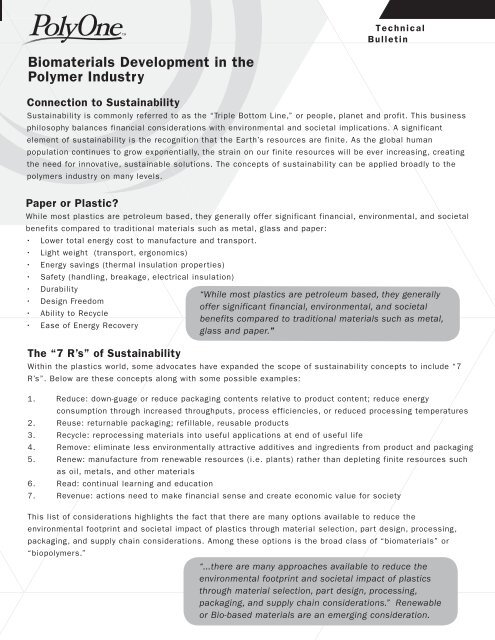

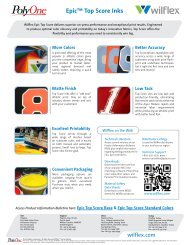
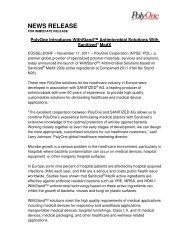

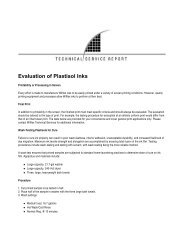
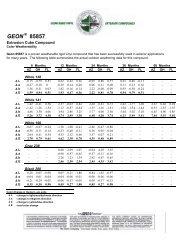
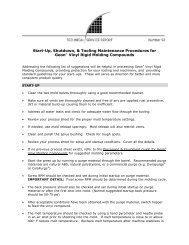
![TPE Injection Molding Guide [PDF] - GLS Thermoplastic Elastomers](https://img.yumpu.com/26329362/1/190x245/tpe-injection-molding-guide-pdf-gls-thermoplastic-elastomers.jpg?quality=85)

